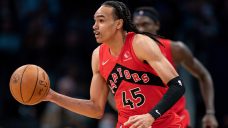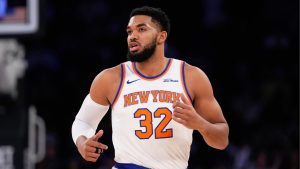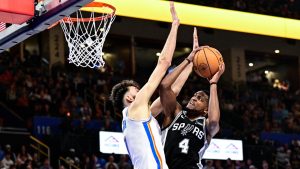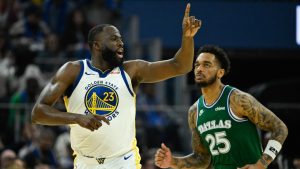The new NBA season coinciding with the holiday every year has resulted in an unbeatable summer tradition: A post-July 1 Raptors cap update written from a patio with a beer.
There’s not much need for preamble after a long weekend so flush with larger, uhh, amble. So, from the wobbliest table in all of Toronto, here’s a look at the Raptors’ moves and non-moves over the weekend from a more cap-oriented perspective.
Where things stand
In case you’ve missed it, the Raptors are now different in the following ways: Fred VanVleet (Houston) and Dalano Banton (Boston) are out, Dennis Schroder and Jalen McDaniels are in, Jakob Poeltl and Thaddeus Young are back, and Will Barton (UFA), Jeff Dowtin Jr. (RFA), and Ron Harper Jr. (RFA) remain free agents.

The Raptors now have 14 guaranteed contracts on the books, totalling $158.44 million. That’s well over the cap but about $6.1 million below the luxury tax line. In other words, they could fill their final roster spot with a salary up to $6.1 million and still stay below the tax.
That framing isn’t entirely helpful for a couple of reasons that we’ll discuss within. Foremost, the new contract for Poeltl could be structured a few different ways to maximize space now or later. The Raptors also don’t have any means of adding a $6.1-million player — they’re down to just minimum contracts to offer, plus the possibility of trades. The possibility of trades, whether to add or balance the roster, colours this as well.
Big picture, about $6 million in wiggle room to finish tweaking the roster is helpful to know.
Schroder and McDaniels added with exceptions, Raptors now hard-capped
After VanVleet signed with Houston, Toronto pivoted and used its full non-taxpayer mid-level exception and bi-annual exception to sign Schroder and McDaniels, respectively.
Those two exceptions are only available to teams operating above the salary cap but not deep into the luxury tax. More importantly, they also “hard-cap” the Raptors. The CBA doesn’t allow you to use these exceptions and then end up deep into the tax and shrug your shoulders like “oops, me? Sorry!”
The Raptors will now not be able to exceed $172.35 million in salary at any point this season. It’s very unlikely that matters since they’re about $13 million from that line, anyway, but there you have it.
This also means the Raptors are out of exceptions. As an above-cap, below-tax team, the mid-level and bi-annual were the only ways the Raptors had to give out contracts beyond the minimum. (The smaller taxpayer mid-level exception is for above-tax teams, while the room exception is for teams with actual cap space; the Raptors do not possess any trade exceptions.) The bi-annual exception also will not be available to Toronto for 2024-25.
Optimizing a Poeltl contract structure in a post-VanVleet environment
The numbers for Poeltl’s deal in the graphic above are based on minimizing the 2023-24 cap hit. That was what we assumed the Raptors would do if VanVleet was back, allowing the team to fit both returning free agents in under the tax. It was going to be a delicate dance, one that required maximizing every penny.
Now that VanVleet is gone, the Raptors could do a few different things instead. Because no deal can be made official until Thursday, the Raptors can sit back and wait to see which Poeltl framework is most beneficial to them. Poeltl has to agree to those frameworks, but considering he got a very healthy $20 million per year and a fourth-year player option, my guess is that he would play ball.
The easiest option is to just pay Poeltl $20 million in all four seasons. Nice, easy math, and with the cap expected to keep rising, it would effectively decrease Poeltl’s share of the cap room each year. But that doesn’t maximize or minimize space in any one season; what if the Raptors wanted to fully frontload the deal so his cap hit is as small as possible in future years? To do so, they could bump his first-year salary as high as $22.72 million. That would leave the Raptors without enough room to sign a 15th player beneath the tax, necessitating a trade elsewhere (or a short roster, which is not ideal in a building year). You could also try to get the best of both worlds, giving Poeltl a starting salary around $21.75 million (enough to sign a 15th player), then dipping for two years so that it’s minimized in 2025-26 (when a new deal for Scottie Barnes would kick in), then coming back up for 2026-27 (so Poeltl has a fair-market player option decision).
A lot of options! Once the paperwork on the deal is filed and this becomes public, we’ll know a bit more about the Raptors’ thinking here. A “4x20” can mean a lot of different things!
Why let Young’s contract guarantee?
A non-move that took place Friday was the Raptors deciding not to waive Young, who could have been waived with just a $1-million cap hit. Instead, the Raptors are now on the hook for the full $8 million.
It was a foregone conclusion that Young would have been waived if VanVleet had returned, as the math around the luxury tax was just impossible with Young, VanVleet and Poeltl all in the mix.
So, why not waive it anyway, since Young is unlikely to be worth $8 million? There are a few possible reasons.
It’s important to keep in mind, for example, that after VanVleet left, waiving Young gave the Raptors nothing but tax wiggle room. They would not have had an extra $7 million to spend, as they don’t have anything to offer other than the minimum contract. In that sense, it’s “just” money — $8 million to have Young or $1 million to have nobody.
I also mentioned that the Raptors don’t have any trade exceptions. Young can now function as a sort-of human trade exception, with his $8-million contract helpful for salary-matching in trades. (I feel bad discussing players like that; in this case, Young got an extra $7 million for his trouble, so I think he would understand.) Again, this is a question of something or nothing -- Young’s salary for matching purposes or just a hole in the roster sheet.
That’s not to say there aren’t arguments against it. The money is real! So, too, is the opportunity cost of not being able to use that roster spot on another developmental player or lottery ticket free agent. The Raptors obviously felt the value of the trade chip, the roster player and the veteran presence Young provides were all worth that opportunity cost.
Why not a sign-and-trade for VanVleet?
One of the most popular questions heading into free agency is always what sign-and-trade possibilities look like for outbound free agents. Sign-and-trades are a flexibility tool for teams and players, allowing teams without cap space to still acquire free agents and get something for their outbound players.
VanVleet-to-Houston has not been reported as a sign-and-trade, at least not yet.
Houston had more than enough cap space to sign VanVleet outright, giving the Rockets all the leverage in such a discussion. Their deal for Canadian Dillon Brooks is being reported as a sign-and-trade, so they could simply tell the Raptors, “Look, we have the space to sign Fred, and Memphis is playing ball on Brooks, we don’t need to give you anything.” There are still some (small) reasons Houston may do it, and VanVleet getting three years (instead of the previously reported two-year deal) makes a sign-and-trade legal.
More realistically, though, it’s the Raptors who would want the sign-and-trade. Even if they get no players in return, sign-and-trading VanVleet would create an enormous traded player exception for Toronto. That exception would later let the Raptors take a player back in trade without making the salaries match. It could be valuable now, at the deadline, or at the start of the next free agent period. We’ve even seen teams in the past send picks with their outbound free agent just to create such an exception. Toronto isn’t in a draft-asset situation to do that, but it does highlight how highly teams value a large trade exception.
Keep an eye on the news between now and Thursday, when VanVleet’s deal can become official. If Houston is getting involved in even more transactions, the chances expand slightly for the Raptors to get a little nibble, even just an exception.
Banton to Boston
In a much lesser flight, Banton is off to the Celtics on a reported two-year deal. End-of-roster developmental players change teams all the time, so this is only of note for two reasons. For one, the Raptors could have kept the right to match this offer had they tendered Banton a qualifying offer last week, which they declined to do. The other is that team president Masai Ujiri and head coach Darko Rajakovic both talked Banton up in recent weeks, making his departure at least a small surprise.
Again, these things happen all the time. Banton fell out of the rotation on merit and had a very up-and-down time with Raptors 905. He’s not a sure-fire bench piece in the NBA. It’s a couple times in recent years now, though, that well-run organizations have jumped on developmental pieces the Raptors have decided to move on from. An area the Raptors thrived in for years has become a neutral area.
We’ll see if Banton joins the Oshae Brissett, Gary Payton II, Ish Wainright, Yuta Watanabe class of guys who clicked elsewhere, or if he’ll be one of two-dozen players in this same position next year.
Gary Trent Jr. extension possibilities
It was reported this weekend in a few places that the Raptors and Trent’s camp are working on a long-term extension. That became a possibility when Trent opted in to his 2023-24 contract, and thanks to the new extension rules in the new CBA.
Trent could sign a four-year extension worth up to $116.41 million total. That total is well beyond what Trent should receive, but it gives the two sides a much wider band to negotiate within than they had under the old CBA.
As a procedural note, Trent would be ineligible to be traded for six months after signing the extension unless it’s an extend-and-trade deal. Extend-and-trade rules were also amended in the new CBA, though perhaps not enough for Trent to agree to one, as his earning potential there is less than in a straight extension (or unrestricted free agency next summer if he has a good year).
The Jeff Dowtin Jr. Rule
Remember the discussion around whether Dowtin could be eligible for the play-in game despite maxing out the NBA days on his two-way contract in April? No, just me? Anyway, the league closed that uncertainty in the new CBA, specifically stating that play-in games don’t count toward regular season totals for two-way days, statistical categories, award eligibility, and so on.
The Dowtin Jr. Rule now joins The Malcolm Miller Rule, The John Salmons Rule, The Matt Barnes Rule, The Jordan Loyd Rule, and some others in the book of CBA rules that aren’t specifically about the Raptors yet I will always claim they are.
Trade rules in the new CBA
Back to actual rules that matter to you. The rules around how salaries match in trades have changed for this new CBA, and that’s pretty important if the Raptors are looking to make a roster-balancing trade or, oh I don’t know, trade away their franchise player for a big package.
The trade rules are different depending on where teams are in relation to the salary cap and luxury tax. As an above-cap, below-apron team, the Raptors are subject to the following:
— If outbound salary is less than $6.53 million, they can receive 200 per cent of the outbound salary plus $100,000.
— If outbound salary is between $6.53 million and $19.6 million, they can receive the outbound salary plus $7.5 million.
— If outbound salary is greater than $19.6 million, they can receive 125 per cent of the outbound salary plus $100,000.
These rules are more strict for tax teams, so all sides involved will have to be careful structuring any deal around tax and apron levels.
What’s next, and where the roster stands
The Raptors have 14 guaranteed contracts, one non-guaranteed contract (Joe Wieksmap), one two-way contract (Markquis Nowell), and one Exhibit 10 contract (Kevin Obanor) signed. (Exhibit 10 contracts give a player a chance to fight for an actual or two-way spot, then give them a $75K bonus if they’re waived and stay with Raptors 905 long enough.) A team can have as many as 21 total contracts on their books through the summer and camp, so you’ll see more additions in the coming weeks.
The Raptors only have minimum contracts, two-way contracts and Exhibit 10 contracts to offer right now. Dowtin, Harper, summer league standouts, and low-cost free agents are all possibilities in those last few spots. Wieskamp being waived before his July 18 guarantee date or a trade could also open up more roster room, too.
Summer League roster
The Raptors are one of the last teams to announce their roster for Summer League, which is underway shortly with game action beginning Friday.
First-round pick Gradey Dick will lead the group of roster players, a list that will also include Nowell, Obanor and Wieskamp. Christian Koloko would make sense. RFAs Dowtin and Harper could also play, as we’ve seen unsigned RFAs suit up in the past as they continue to compete for a deal.
Desmond Cambridge Jr., D.J. Hogg, David McCormack, Ahmad Caver and J.T. Shumate have been reported as Summer League invites, as well.
What team a player is with for Summer League doesn’t matter a ton if they don’t have an NBA deal. It’s a showcase for all 30 teams, and the Raptors haven’t been shy signing from another Vegas roster if the right player popped.



 1:00
1:00

